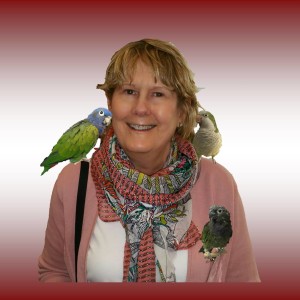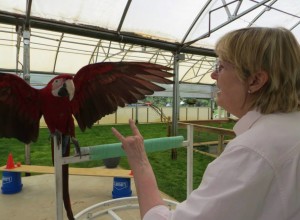Wolf Park Indiana – A Howling Good Time!
Wolf Park Journey
 My recent visit to Wolf Park in Battle Ground, Indiana for an advanced animal training seminar was most certainly a “right place at the right time” experience of a lifetime.
My recent visit to Wolf Park in Battle Ground, Indiana for an advanced animal training seminar was most certainly a “right place at the right time” experience of a lifetime.
It all began last November at the Pet Professional Guild’s first Educational Summit. I happened to be sitting next to Ken McCort who mentioned that he was hoping to start a program at Wolf Park that had been five years in the works.
He’d finally gained approval to move forward and would soon be accepting applications (a thorough, comprehensive application) for professional animal trainers to join in an “Advanced Professional Trainer Workshop” at Wolf Park. This was a new concept as they hadn’t had individuals other than long standing staff work directly on behavior with the animals.
Animals are keen observers and learners and one risk was the possibility of accidentally training unwanted behaviors or behavior chains with the wolves. For example, teaching the animals that jumping on people was reinforcing or that stealing treats was worthwhile, could potentially undo all of the important behavioral training they have been working on for over forty years at the Park.
For this reason the application was created to be very selective of professionals with science based behavior and training experience, knowledge, and skills.
As such, Ken managed to bring together an amazing group of individuals. One of the bonus benefits being that we all worked alongside and collaboratively with each other providing feedback, coming up with training plans, and observing behavior.

There was also a pervasive pressure to not bungle this opportunity for the future so everyone was very much aware of the need to be vigilant about body language (ours AND the animals’) and communication.
The weekend was a gathering of fantastically skilled trainers and behavior consultants who each were able to contribute to understanding, planning, and fine tuning interactions.
Wolf Park Training Component
On the first day, we met in the morning for a safety briefing where we discussed use of space, what a “rally” (excited wolf greeting) entailed, tail carriage and other unique body language, which included the directive to “face the wolf as turning your back may make you into a squeak toy”– a task easily planned, but more tricky to execute when literally faced with a wolf.
Ken McCort also gave us some great background on the animals that we’d be working with including foxes as solitary hunters vs. wolves who hunt cooperatively. We also discussed social relationships, hazard avoidance, and training tips to include arousal awareness as arousal could produce predation.

Later on we prepped for our animal “meet & greets” where we worked on establishing a reinforcement history via carefully planned introductions. We broke off into smaller groups to visit the bison and wolves. On the truck with the bison our initial ideal behavior was to work on target training from the back whilst other trainers occupied the rest of the herd.

However, this materialized into working individually with all of the animals except the young calf via targeting, marking and reinforcing from both sides of the truck and the front cab eventually, too!
Over the course of the three days we continued to feel more comfortable about our encounters whilst always remembering not to become complacent. During breaks we watched videos of groups training and worked on training plans.
Within enclosures with the animals we practiced target stick training and shaping eye contact with bison, desensitization and proximity to novel humans with foxes and wolves, attention and recall with coyotes via protected contact, and shaping behaviors to include a down, harness cooperation, and a fox-on-shoulder behavior.
All of the behaviors were in an effort to interact as part of a socialization program working to reduce the animals’ innate fear of humans in order to improve upon their communication and voluntary interactions in their environment for physical and mental welfare and well being.
Wolf Park Final Thoughts
Many of the folks who attended the professional training workshop have expressed that upon returning home it was akin to experiencing a bit of “culture shock” as we got back to the day to day work of returning emails, interacting with clients, and everyday life.
The Wolf Park Advance Professional Trainers Workshop was no less than a “big hit” with the remarkable group in attendance, staff, and the animals.
A special thank you to Ken McCort and the staff at Wolf Park for organizing and orchestrating this wonderful learning experience.
Too, being able to share this weekend with such remarkable people was super! Thanks to all for sharing this incredible learning adventure – Susan Friedman, Jennifer Ackley, Douglas Duncan, Marie-Elisabeth Gagnon, Ruth Larocque, Jean Lessard, Peggy McCarty, Michelle Mullins, Chirag Patel, Mary Penny, Tess Starr, Nancy Tucker, and Mara Velez.

(Note: If you would like to take your training skills to the next level and become a professional animal trainer or just train like one, then come and learn with me in Miami June 26-30, 2017 (application deadline: December 20, 2016, https://www.karenpryoracademy.com/dog-trainer-professional/national/miami-fl).)

 I came to know Miki as a wonderful resource via my work with deaf dogs. Miki has provided fantastic training advice for blind dogs and our audience/questions and answers often overlapped. Miki lives in Japan and has published in both English and Japanese!
I came to know Miki as a wonderful resource via my work with deaf dogs. Miki has provided fantastic training advice for blind dogs and our audience/questions and answers often overlapped. Miki lives in Japan and has published in both English and Japanese!
 Patricia and I met at Ken Ramirez’s Professional Animal Trainers Workshop. She has an amazing knowledge set when it comes to anything bird and I’m happy to learn and share more about what brought Patricia to the positive reinforcement training world!
Patricia and I met at Ken Ramirez’s Professional Animal Trainers Workshop. She has an amazing knowledge set when it comes to anything bird and I’m happy to learn and share more about what brought Patricia to the positive reinforcement training world!